In recent years, new liquid, non-fumigant nematicides (products that move through the soil as a liquid rather than a gas) have become available. With that increase, I have received more questions about which product to choose, particularly in vegetable crops such as watermelon, sweetpotato, or potato that may not be fumigated. This article summarizes common nematicides and factors in choosing which nematicide to use.
–
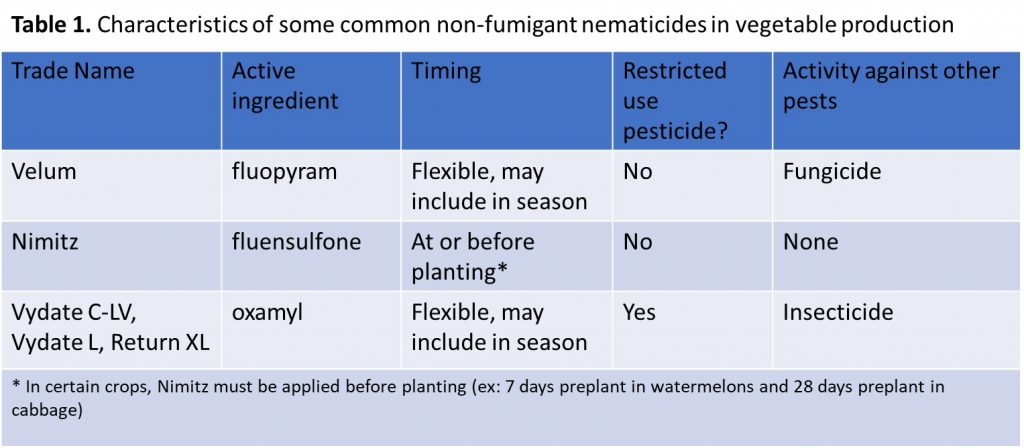
There are three conventional nematicides available for most horticulture crops: Nimitz (fluensulfone), Velum (fluopyram), and oxamyl products: Vydate C-LV, Vydate-L, and Return XL. Some characteristics and label requirements of these products are listed in Table 1. Nimitz and Velum are newer chemistries and less toxic to handlers, so they have fewer restrictions. In contrast, oxamyl products are restricted use pesticides. Application methods are generally similar for all products. In plasticulture, the nematicides are generally applied by drip irrigation. In bare ground crops (potato, sweetpotato, etc.), products are typically applied by overhead irrigation, drench, or in-furrow or broadcast spray depending on the crop and product. Application methods vary by crop and product, which may influence product choice. See product labels for details on application methods in particular crops.
–
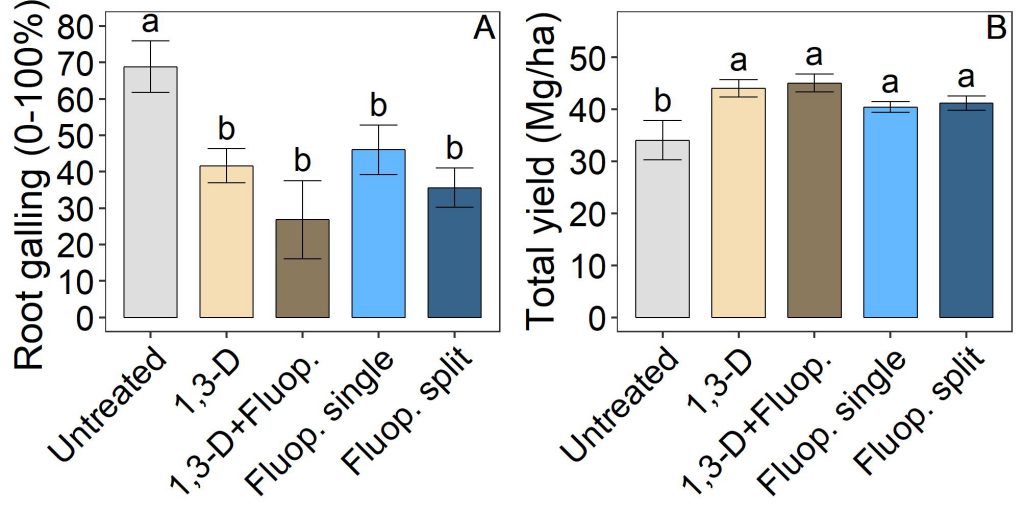
Figure 1. 2018 tomato trial at North Florida Research and Education Center-Suwannee Valley. Root galling at harvest and total yield as affected by nematicides. “Fluop.” is Velum through drip irrigation and “1,3-D” is Telone II shank fumigation. Values with the same letter are not statistically different.
–
Velum or oxamyl products are likely to be the product choice in situations where growers intend to apply a nematicide at, or after planting, as these products are labelled for that timing in many crops. In contrast, Nimitz is not labelled for in-season application, and requires a preplant interval in certain crops. Even for products labelled for in-season application, it is recommended to make at least one nematicide application before or around planting as this timing—before nematodes have infected plants—is most effective.
–
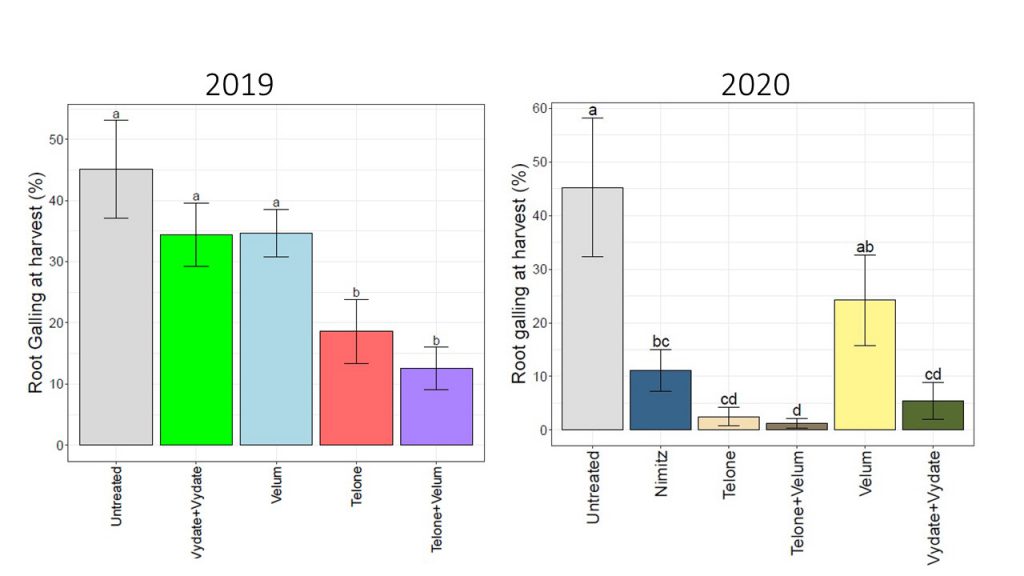
Figure 2. 2019-2020 tomato trials at North Florida Research and Education Center-Suwannee Valley. Root galling at harvest as affected by nematicides. Velum, Nimitz and Vydate were applied through drip irrigation. Telone was broadcast shank fumigated.
–
Product efficacy is also an important factor in product selection. The efficacy of newer products continues to be evaluated and performance may vary based on crop, nematode and application method. In general, all of these nematicides can have efficacy at managing nematodes, but none are likely to be as consistently effective as fumigation. Here are some examples from recent research trials. In tomato at North Florida Research and Education Center-Suwannee Valley (NFREC-SV), Velum performed similar to Telone in a 2018 trial for managing root-knot nematode root damage (Figure 1). In subsequent tomato trials (Figure 2), neither Velum nor Vydate was very effective in 2019, whereas Vydate and Nimitz were more effective than Velum in 2020. In a 2018 watermelon trial at NFREC-SV, both Velum and Nimitz were effective at reducing root damage from root-knot nematode (Figure 3). Finally, in 2018 at Hastings Agricultural Education Center, none of the products were statistically effective at reducing sting nematode populations in potato production, but Nimitz and Vydate looked numerically better than untreated. Note that some of these trials tested non-fumigant nematicides in combination with Telone II, a common fumigant, but adding the extra nematicide generally did not increase nematode management.
–
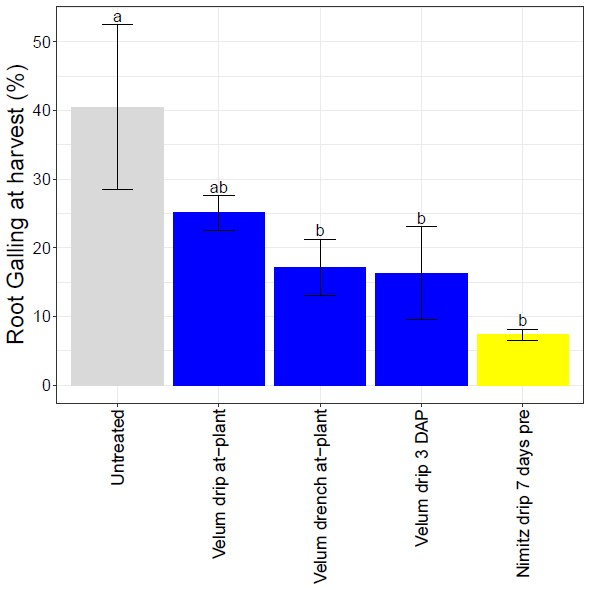
Figure 3. Watermelon trial at North Florida Research and Education Center-Suwannee Valley. Root galling at harvest as affected by nematicide application. Values with the same letter are not significantly different.
–
In summary, non-fumigant nematicides are available and can improve nematode management in horticulture production, particularly crops where fumigation may not be cost-effective. Know label requirements for application methods and timing, as that will influence which product can be applied in a particular situation. Also use efficacy data to guide product choices.
–
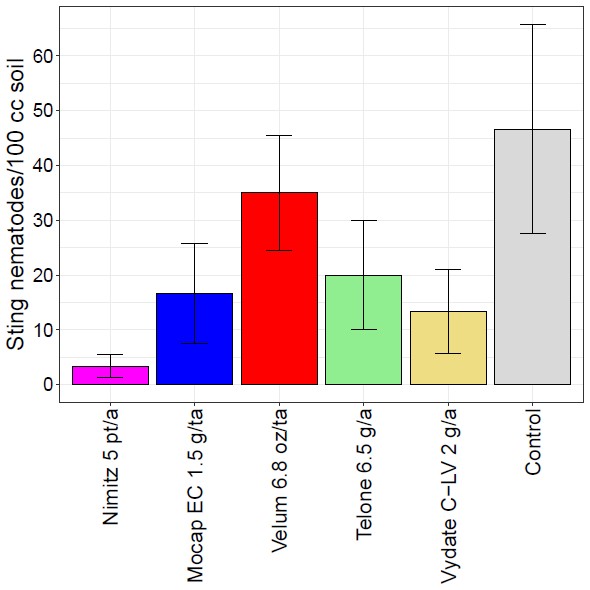
Figure 4. Potato trial at Hastings Agricultural Education Center. Sting nematode soil populations at harvest as affected by nematicide treatments. Telone was applied as a preplant shank fumigation. All other nematicides were sprayed preplant and tilled in. Values were not significantly different.
- Salibro: A Recently-Registered Conventional Nematicide for Select Horticulture Crops - March 7, 2025
- What Cotton Cultivars have Resistance or Tolerance to Southern Root-knot and Reniform Nematode? - February 28, 2025
- How Well Do Root-Knot Nematode Resistant Peanut Cultivars Perform in Florida? - February 14, 2025
